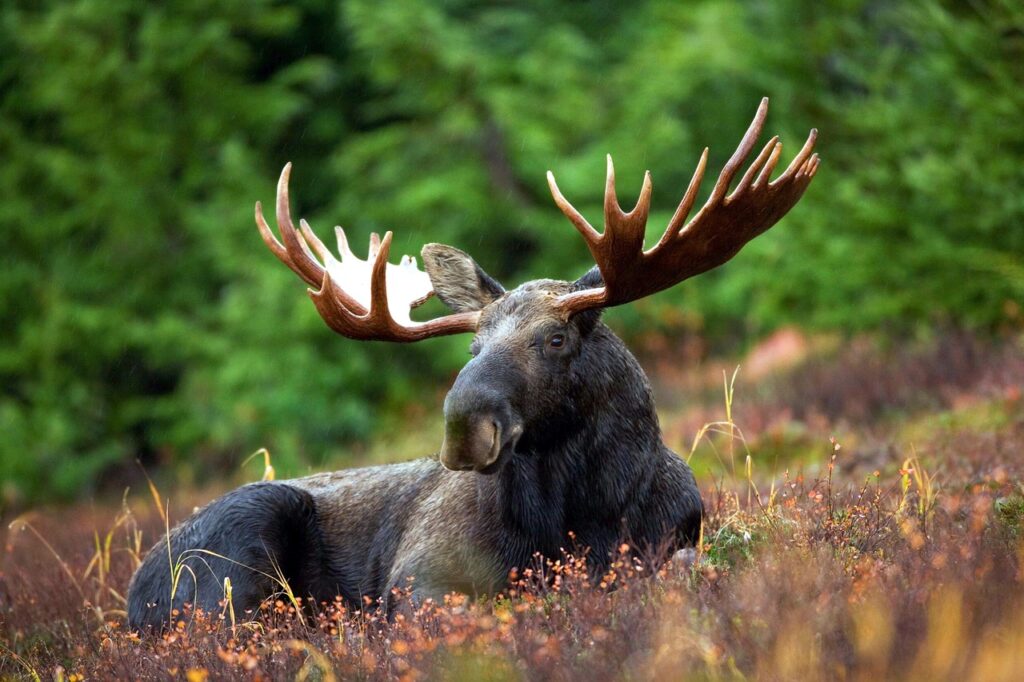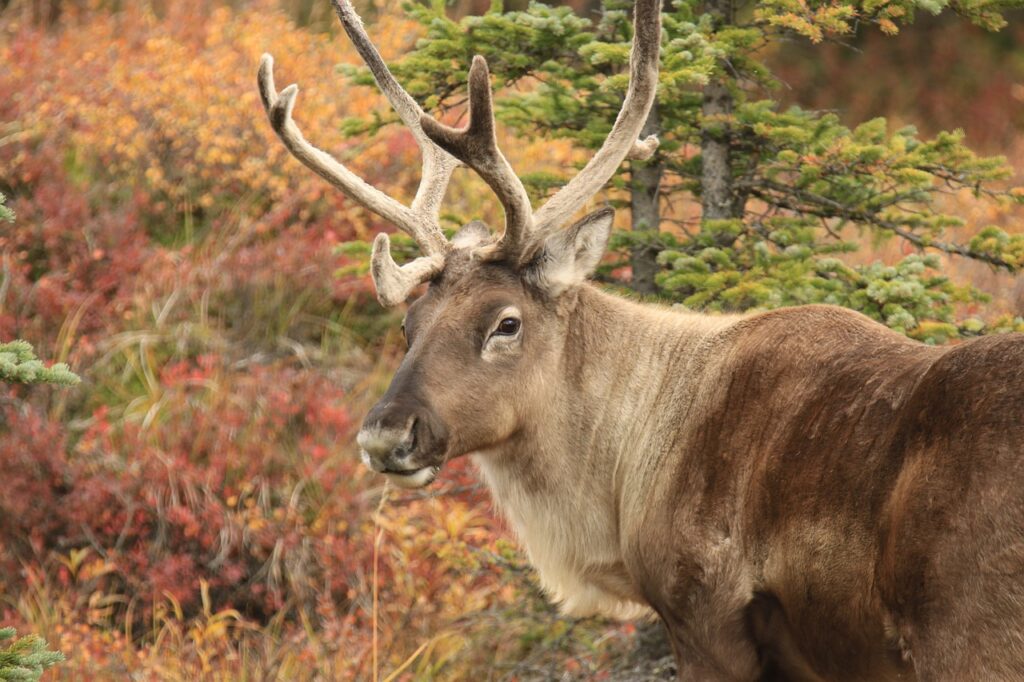Differences Between Moose And Caribou
These two magnificent North American mammals are a sight to behold. Both are towering over us humans with their large size and – depending on the season – a massive set of giant antlers – these mammals are very different even though they are closely related. These wonderful creatures are well-loved but often confused with each other – so here we will look at some traits about them that can help tell them apart.
5 Easy Ways To Tell A Moose And Caribou Apart
1: Antlers: Caribou antlers are thin and spiky, unlike the flat antlers of a moose
2: Faces: Moose have very long distinct faces and droopy chins – but caribou are sharper
3: Size: The Moose can weigh more than 3 times that of an adult male caribou
4: Color: Both moose and caribou have very different pelts
5: Lifestyle: Caribou are herd-dwelling mammals, but moose go it alone
It may not be so clear on a few of these things in images, but there are still some obvious differences if you look close enough. Once you have picked up on one difference, it is easy to work through the others and break it down into the basics. Even though they are both deer-like mammals – they are miles apart when you look closely.
1: The Antlers Of Both Species Are Shaped Very Differently
Antlers are grown fresh every year by moose and caribou – and they get larger every year they are grown. They do, however, grow in different ways, so it is straightforward to tell which is which. Antlers of the moose are called ‘palmate’ and reflect that description: like a palm. They have one large flat plate-like area (like the palm of your hand) with shorter spikey bits coming off it (like your fingers). A moose can have antlers reaching over 6m (19ft) wide, almost as wide as they are tall.
Caribou, on the other hand, grow very different-looking antlers. They are divided up into prongs and tines, all branching off of one main stem. Relative to body size, the caribou have some of the largest antlers of all the deer (Cervidae family – of which both caribou and moose are members). However, they are usually only about 1m (3.3ft) in span and about the same height. Female caribou always have antlers, whereas female moose never do.
2: Moose Faces Are Very Distinct, And Their Heads Are Massive
Moose faces are unforgettable – and compared to a caribou face – unmistakable. With their giant droopy lips and huge rounded nose, as well as their whole head, being gigantic, they really can’t be confused with the smart, svelte, thinner face of the caribou. Caribou faces are very short-haired, and the nose itself is clearly defined – unlike that of the moose.

Moose also has a hairy dewlap under their chin – sometimes over 20cm (8in) long and thick brown or black hairs. Both sexes have this hairy patch just under hanging there – but the reason for it is still unknown. Some caribou can also have a hairy neck area – but it isn’t as clearly sectioned off as in the moose. It is more like an extra shaggy under-mane that can extend down to the chest.
3: Moose Weigh More Than The Smaller Caribou
Moose are enormous – the largest member of the deer family alive today. They vary between the sexes and relative to the rut (when males of both species are at their heaviest beforehand and up to 40% lighter afterward once their antlers are shed), and there have been a few unsubstantiated claims of absolute giants. However, the average weights for moose are as follows: Females: between 200-500kg (440-1080lb), and males: between 380-700kg (840-1550lb). That is colossal.
Caribou are a much more dainty 80-180kg (180-400lbs) as adults – still about as heavy as a Pygmy Hippo, but so much more dainty. They are quite agile too when running across the tundra – and are strong enough to act as draft animals too, where people made good use of those very calm and easily domesticated animals.
4: Caribou Are Two-Tone – Moose Are Plain Brown
Caribou come in a wonderful array of color patterns with their brown and white fur. With variations from all dark brown to all creamy-white, there are a whole host of combinations. Their coat is long and wispy in places, and so these delicate color patterns can move and change with the wind and with the season. Most caribou have a paler neck pattern, which in some individuals extends along the flanks or the entire back. They also all have a white tail and rear end – like most hard-living deer – to act as a ‘follow me’ signal when they take flight.

Moose aren’t quite so flashy. They are brown all over. They don’t have creamy necks, pale flanks, or flashy white rumps. It’s all just brown. Their fur isn’t quite as fluffy and lightweight either, more of a thicker dense coat. There have been sightings of rare white moose, though – a type of leucism in the species which looks amazing.
5: Caribou Are Herd Animals – Moose Are Rather Solitary
Moose are almost always found on their own – they live a solitary life in the woodlands they call home. Only when gathering in large numbers during the rut in fall and when females are with their young will you see them together for the first year. Otherwise, they are happy to be alone. A slow life with no regular predators as an adult, they have a relaxed life. Wolves or bears sometimes predate young moose – so it isn’t always easy.
On the other hand, Caribou is predated all the time as adults by packs of wolves – but a healthy alert adult won’t usually get caught. Living in huge herds, only the weaker or less cautious individuals will get caught in a chase or ambush. Found in herds of up to 500,000 animals during spring migrations – they have protection from the sheer numbers. However, young deer don’t always benefit from the herds as they are most likely taken.
Frequently Asked Questions
Are Caribou And Reindeer Different?
No, caribou and reindeer are just two names for the same animal – Rangifer tarandus (Latin names are often safer). So, Caribou in the U.S. and Reindeer in Europe. It isn’t the only thing: Why is the moose is called an Elk in Europe too? There are suggested reasons for both to explain why but we shall never really know why the different names stuck fast – rather than being amalgamated into one.
Can Moose And Caribou Have Offspring Together?
Not naturally, due to the way they live and the size differences, they are very closely related, so it might not be impossible but is never seen. The moose is the only member of the genus Alces, and the caribou (Rangifer) is more closely related to White-tailed Deer and Mule Deer.
Who Would Win In a Fight?
The moose would certainly win and a head-to-head rutting fully-antlered fight. During the rut, the males are so heady on hormones that they will wear themselves out fighting to maintain their patch from others – no matter what the cost. And these hormone-fueled males do not give up. Males of both species can die from injury or starvation while defending their patch, so the relatively small caribou would have to get lucky with an antler strike to stand a chance.
Why Do Female Caribou Have Antlers?
Answer: It is believed to be because they use their antlers to dig up snow while feeding in the cold winters – so without these, they could well starve. Females from other cervids do sometimes sprout antlers too, so it could have been an acquired physical trait for sure. However, others believe it is down to hormones for cold-weather adaptation. Either way – females keep their antlers longer than males – so if you see a reindeer in the winter holidays with antlers – it’s a female.
Are Moose Stupid?
Answer: No. Of course not – they just have facial characteristics that have been associated with TV characters who act relaxed and speak slowly. Therefore, you have been programmed to hear a silly voice and a somewhat ‘daft’ tone when you see a moose. There is nothing stupid about a moose. They need to be on top of their game to survive in the habitat and climate they specialize in.
Can You Ride A Moose?
Answer: No, they are wild animals and don’t take kindly to people hitching a ride. They may well be strong enough to take the weight of a human – but they are in no way tolerant of humans even with repeated contact. There were many stories about moose being trained for battle – but of course, it didn’t work. Otherwise, we would still be doing it today? They were scared of the sound of gunfire.

